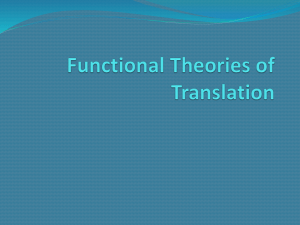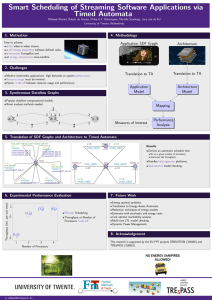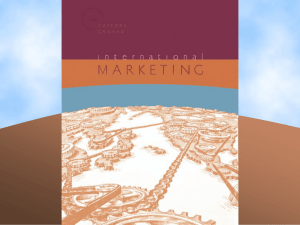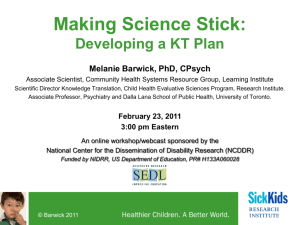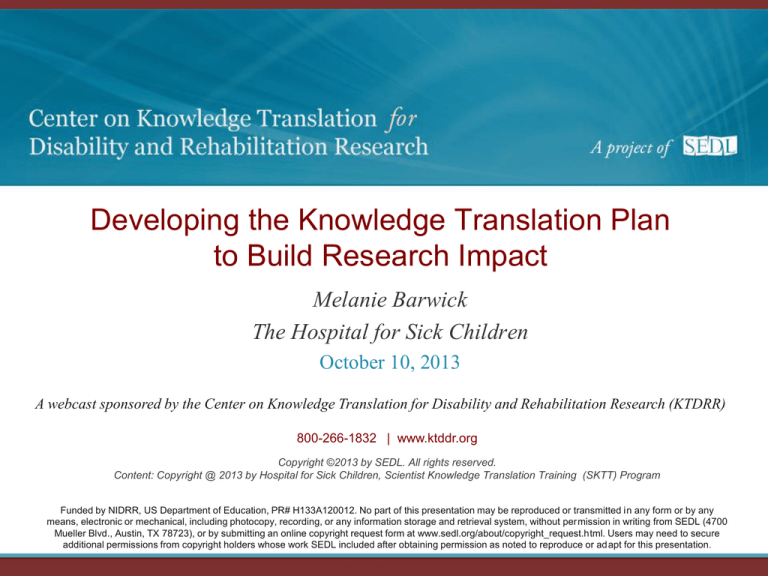
Developing the Knowledge Translation Plan
to Build Research Impact
Melanie Barwick
The Hospital for Sick Children
October 10, 2013
A webcast sponsored by the Center on Knowledge Translation for Disability and Rehabilitation Research (KTDRR)
800-266-1832 | www.ktddr.org
Copyright ©2013 by SEDL. All rights reserved.
Content: Copyright @ 2013 by Hospital for Sick Children, Scientist Knowledge Translation Training (SKTT) Program
Funded by NIDRR, US Department of Education, PR# H133A120012. No part of this presentation may be reproduced or transmitted in any form or by any
means, electronic or mechanical, including photocopy, recording, or any information storage and retrieval system, without permission in writing from SEDL (4700
Mueller Blvd., Austin, TX 78723), or by submitting an online copyright request form at www.sedl.org/about/copyright_request.html. Users may need to secure
additional permissions from copyright holders whose work SEDL included after obtaining permission as noted to reproduce or adapt for this presentation.
Why Plan for Knowledge Translation?
1)
2)
3)
4)
Because it is a requirement for many research funders
Because if we don’t plan for it, it won’t happen
Because if it doesn’t happen, it will sit on the shelf or in a journal
Because we owe it to tax payers to show what we accomplish with
public funds
5) Because funders want to demonstrate return on investment – and
consequently, so do you and the organization for whom you work
6) Because we need to demonstrate the impact of our research
7) Because we want to advance science and practice
And that means, getting what we know works to improve health
and well-being into the hands of people who can apply it.
2
Key Components of a KT plan
1)
2)
3)
4)
5)
6)
7)
8)
9)
What are your KT goals?
Who are your target audiences / knowledge users?
How will you engage them?
When will you engage them?
What are your main messages?
What KT strategies will you use?
How will you implement your strategies?
With what impact (evaluation strategy to determine success of KT
plan and impact on health)?
What resources are required (budget, staffing, etc)
It starts with identifying your KT Goals:
What is your purpose in sharing what you learned?
Generate awareness & interest
Share knowledge
Inform future research
Generate practice change (practitioners) or behavior change (people)
Generate policy action
Mobilize public action
Commercialization or patent
4
Who is your audience?
Who?
• Who needs to hear your message?
How?
• How well do you know their
preferences, needs?
Act?
• How receptive are they to hear
your message? How prepared are
they to make decisions?
Blocks? • What are the barriers to action?
5
Who are your Knowledge Users?
Consumers
Health Practitioners
Managers (hospitals, workplaces)
Policy makers
General Public
Patients
Media
Private industry
Advocacy groups
Research funders
Decision makers
Research scientists
Other?
6
Consider:
• How to involve KUs in project development,
interpretation, discussion, knowledge translation
activities
• What information KUs need, rather than what you
think they need
• How to tailor main messages & KT strategies to KU
preferences for format, timeliness, functionality
• One-on-one and face-to-face interaction work best as a
base from which to add more virtual formats
• Perceived credibility of the messenger is important
How to Engage: formats for communication
Journals
Networks
Newsletters
F2F
Web 2.0
Channels of
Communication
Presentations
Television
Conferences
Radio
Newspapers
For Report Writing - Consider the 1:3:25 Format
1 page: Main messages
3 pages: Executive Summary
25 pages: The Report
Main messages in bullet point
format
Summary of findings condensed to
service the needs of the knowledge
user
Try not to revert to academic prose
Lessons knowledge-users can take
away from the research
Include examples that a knowledge
user would understand
Maintain focus on your knowledge
user audience
Implications your work has for
theirs (the “so what” piece)
Lead with the most interesting
aspect of the research, followed by
your approach; less on methods and
other details (link to additional files
if needed)
Consider using headings:
Context,
Implications
Approach
Results
Additional Resources
Further Research
Reference & Bibliography
If possible, provide
This section is NOT an academic
recommendations for practice and/or abstract
policy
Source: adapted from Canadian Health Services Research Foundation
When will you engage them?
End of Grant KT: Typical dissemination and communication
Integrated KT: throughout the research process, as you work
collaboratively to shape research process. Knowledge users can assist at
different time points:
• Research Initiation: prioritizing, defining, proposing research ideas
and refining questions (that are feasible and practical)
• Conducting Research: data collection, analysis, interpretation
• Communication and Knowledge Translation: message
development, connecting to targeted audiences, assistance with
formats (newsletters, web, webinars)
What is a main message?
A clear, concise, audience-focused statement
Not simply data or findings but rather:
• what the research results mean,
• why they are important,
• what action should be taken as a result (if any)
Tailored to KU needs and preferences
Note: results of a single study can differ from the body of
research and have different implications for different
settings, so it is helpful to include the context as part of the
message.
The Message: ‘KISS’ principle
“In layman’s terms? I’m afraid I don’t know any layman’s terms.”
By Nick Downes. Used by kind permission of The Spectator, 28 APRIL 1990, 50.
Clear communication
Why are you
communicating?
To report
To ask
To inform
To influence
To explain
What do you want to
say?
How do you intend for
the reader to use this
information?
Focus on the needs of
the knowledge user
Effective if reader can
understand the message;
Efficient if reader
understands it the
FIRST time
Address their needs and
questions
Include only essential
information (link to
other)
Plain language writing:
Don’t overload
sentences
Use active voice
Keep sentences short
Keep sentences simple
Avoid ambiguity
Emphasise the positive
Avoid double negatives
13
Learning Checkpoint
Which elements are universal components of KT?
Goals
Audience
Engagement
Main message
Strategy
Implementation
Impact evaluation
Resources
All of the above
Consider the Evidence for KT Strategies
Adapted from Grol R & Grimshaw J 2003
Participatory research
Consultants
Interactive small groups
Clinical Practice Guidelines
Conferences
Communities of
practice
Academic detailing
Opinion leaders
Policy Briefs
Reminders
Champions
Networks
Computerized decision support
Educational materials
Patent license
Multi-disciplinary collaboration
Audit and feedback
Social media
Mass media campaign
Patient-mediated
Arts-based KT
Combined interventions
Substitution of tasks
Mostly
Effective
Mixed
Effectiveness
Didactic
Presentations
Limited
Effectiveness
Knowledge Broker
Not Synthesized
Knowledge Translation Planning Template
Assistance in formulating a KT Plan.
Available as free download: www.melaniebarwick.com/training.php
Barwick, M. (2008, 2013). Knowledge Translation Planning Template.
Ontario: The Hospital for Sick Children
© 2008, 2013 The Hospital for Sick Children
16
Purpose
The Knowledge Translation Planning Template © was designed to guide
researchers, clinical educators, and KT practitioners through the KT
planning process in a stepwise manner such that the core elements of KT
planning are considered (Ross, Goering, Jacobson & Butterill, 2006).
It was developed in response to funders’ requirements for KT Plans
alongside research proposals (e.g., Tetroe et al., 2008), in particular the
focus on KT from a range of Canadian funders (CIHR, SSHRC, MSFHR,
AIHS, NSHRF).
17
Applicability
The Knowledge Translation Planning Template © is applicable across all
health pillars (basic, clinical, health services, population health) and across
many sectors (health, mental health, education, social sciences,
environmental sciences).
The KT strategies refer to the current state of the evidence base for
knowledge translation strategies (Grol & Grimshaw, 2003; Boaz, Baeza,
& Fraser, 2011).
The Knowledge Translation Planning Template © supports effective and
evidence-based knowledge translation of research to practice by
individual scientists, research teams, and/or KT practitioners.
18
Educational Objectives
Category
Objectives for The KT Planning Template user:
Remembering: Recall previous learned information.
Knows the core components of KT planning (i.e., partners,
engagement, roles, expertise, knowledge users, KT goals, main
messages, KT strategies, KT process, KT impact and evaluation,
budget and resources, implementation)
Understanding: Comprehending the meaning, translation,
interpolation, and interpretation of instructions and problems.
State a problem in one's own words.
Explains the steps one will follow, and the rationale, for the
implementing the KT plan pertaining to the specific project or research
endeavour
Applying: Use a concept in a new situation or unprompted use
of an abstraction. Applies what was learned in the classroom
into novel situations in the work place.
Produces a KT plan for a specific project or research endeavour
Analyzing: Separates material or concepts into component parts Outlines in step fashion the core elements of the KT plans as it pertains
so that its organizational structure may be understood.
to the project or research endeavour
Distinguishes between facts and inferences.
Evaluating: Make judgments about the value of ideas or
materials.
In selecting KT strategies and KT approach (integrated or end of grant
KT), describes and justifies the processes involved for their use
Creating: Builds a structure or pattern from diverse elements.
Put parts together to form a whole, with emphasis on creating a
new meaning or structure.
Creates a KT plan that will guide the KT activities for a project or
research endeavor
19
Conceptual Background
In Canada, as elsewhere worldwide (Tetroe et al., 2008), planning for
integrated (iKT) and end-of-grant knowledge translation is highly
encouraged by institutions and research funding bodies in an effort to
bridge the research to practice gap (National Research Council, 2001).
Approximately two-thirds of funders reviewed by Tetroe et al., (2008)
request a KT plan as part of a submission for research funding, and many
promote the active participation of knowledge users in core research
activities (iKT).
The Knowledge Translation Planning Template © was developed to guide
the user in the development of a KT plan for a specific research project or
endeavor.
The tool is a universally applicable to health, mental health, allied health,
education, and social sciences.
20
Deployment
The Knowledge Translation Planning Template © is an educational
component of the Scientist Knowledge Translation Training ProgramTM
(SKTT; Barwick, Butterill, Lockett, Buckley & Goering, 2005) and the
Knowledge Translation Professional CertificateTM (KTPC, Barwick,
Bovaird, Parker, McMillen & Warmington, 2011), two professional
development courses.
It has been taught to over 1,460 SKTT participants since its development
in 2008, and to 105 KTPC participants since 2011.
It is available for free as a download on www.melaniebarwick.com.
21
Adaptations & Spread
The Knowledge Translation Planning Template © is widely used, and has
informed the work of, and/or been adapted by, several authors/organizations, with
permission from the author, including:
•KT planning process on www.MakeResearchMatter.org
•Hospital for Sick Children Foundations’ National Grants Programs
www.sickkidsfoundation.com/grants/knowledge.asp
•York University’s Office of Research Services (KMb Unit)
•EENet, Ontario’s evidence exchange network for mental health and addictions
•Included in the tool repository for the National Collaborating Centre for Methods and Tools
(www.nccmt.ca)
•Community First: Impacts of Community Engagement (CFICE) www.thecommunityfirst.org
•Simcoe Muskoka District Health Unit
•Women and Children's Health Research Institute, Community-University Partnership, Faculty of
Extension, University of Alberta
•Addictions Services knowledge brokers in Nova Scotia
•Alberta Addiction & Mental Health Partnership Program
www.mentalhealthresearch.ca/KeyInitiatives/ResearchGrants/Seniors_PwD/Pages/KnowledgeExchange.a
spx
22
Adaptations & Spread (cont’d)
•
•
•
•
•
•
Health Care Programs and Policy Directorate , Health Canada
Community Health Sciences, Faculty of Medicine, University of Manitoba
Ontario Heart and Stroke Foundation
Alliance for Canadian Health Outcomes Research in Diabetes, School of Public Health, University of
Alberta
Occupational Therapy, University of Alberta
Ontario Agency for Health Protection and Promotion
Use and Adaptation Requests
The Knowledge Translation Planning Template © is an open access tool
and the author welcomes communications regarding lessons learned,
contexts in which it is used, and adaptations.
All adaptations to the tool must cite the original author as per the citation:
Barwick, M. (2008, 2013). Knowledge Translation Planning Template.
Toronto, ON: The Hospital for Sick Children.
23
Implementation Guidance
• The Knowledge Translation Planning Template © is readily available
on the web, at no cost (www.melaniebarwick/training.php).
• In its most recent revision (2013), there is space to include notes on the
form. No other materials are required.
• It is recommended that the plan be developed collaboratively by the
(research or KT) team.
24
References
•
•
•
•
•
•
•
Balas, E. A., & Boren, S.A. (2000). Managing clinical knowledge for health care improvement.
In: Bemmel J, McCray AT, editors. Yearbook of Medical Informatics 2000: Patient-Centered
Systems. Stuttgart, Germany: Schattauer Verlagsgesellschaft mbH; 2000:65-70.
Brewer, J. D. (2000). Ethnography. Buckingham: Open University Press. 95.
Barwick, M. (2008-2013). Knowledge Translation Planning Template-Revised©. Toronto,
ON: The Hospital for Sick Children.
Barwick, M. (2009-2013). The KT Game. Toronto, ON: The Hospital for Sick Children.
Barwick, M., Butterill, D., Lockett, D. M., Buckley L & Goering P. (2005). Scientist Knowledge
Translation Training. Toronto, ON: The Hospital for Sick Children / Centre for Addiction in
Mental Health.
Barwick, M., Bovaird, S., Parker, K., McMillen, K. & Warmington, K. (2011). Knowledge
Translation Professional CertificateTM. Toronto ON: Learning Institute, Hospital for Sick
Children.
Bloom, B. S. (1956). Taxonomy of educational objectives, Handbook I: The cognitive domain.
New York: David McKay Co. Inc.
25
References cont’d
•
•
•
•
•
•
Boaz, A., Baeza, J., Fraser, A., & the European Implementation Score Collaborative Group
(EIS). (2011). Effective implementation of research into practice: an overview of systematic
reviews of the health literature. BMC Research Notes, 4:212 doi:10.1186/1756-0500-4-212.
Grol, R., & Grimshaw, .J (2003). From best evidence to best practice: effective
implementation of change in patients' care. The Lancet, 362(i9391): 1225.
National Research Council. (2001). Crossing the Quality Chasm: A New Health System for the
21st Century. Washington, DC: The National Academies Press.
Pohl, M. (2000). Learning to think, thinking to learn: Models and strategies to develop a
classroom vulture of thinking. Cheltenham, Vic.: Hawker Brownlow.
Ross, S., Goering, P., Jacobson, N., & Butterill, D. (2006). Towards more effective peer review
of knowledge translation plans in research grant proposal. Toronto, Canada: Centre for
Addiction and Mental Health.
Tetroe, J. M., Graham, I. D., Foy, R., Robinson, N., Eccles, M. P., & Wensing, M., Durieux,
P., Legare, F., Palmhøj Nielson, C., Adily, A., Ward, J.E., Porter, C., Shea, B. & Grimshaw,
J.M. (2008). Health research funding agencies' support and promotion of knowledge
translation: an international study. The Milbank Quarterly, 86(1), 125–155.
26
Disclaimer
This presentation was developed for grant number H133A120012 from the National
Institute on Disability and Rehabilitation Research (NIDRR), Office of Special
Education and Rehabilitative Services (OSERS), U.S. Department of Education.
However, the contents do not necessarily represent the policy of the Department of
Education, and you should not assume endorsement by the federal government.
Thank you!
Questions? Contact us: ktdrr@sedl.org
Please complete the brief evaluation form:
http://survey.sedl.org/efm/wsb.dll/s/1g166
27






